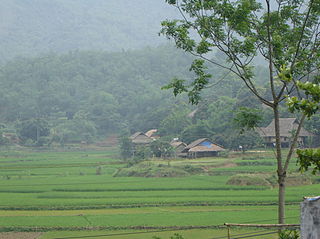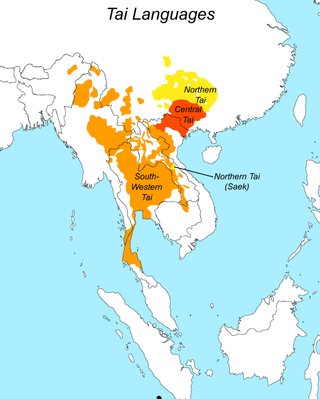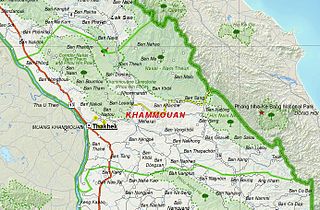
Vietnamese is an Austroasiatic language spoken primarily in Vietnam where it is the national and official language. Vietnamese is spoken natively by around 85 million people, several times as many as the rest of the Austroasiatic family combined. It is the native language of the Vietnamese (Kinh) people, as well as a second or first language for other ethnic groups in Vietnam. It is split into three main dialects, Northern (Hanoi), Central (Hue), and Southern.

The Vietnamese people or the Kinh people, also recognized as the Viet people or the Viets, are a Southeast Asian ethnic group native to modern-day Northern Vietnam and Southern China. The native language is Vietnamese, the most widely spoken Austroasiatic language.

The Mường are an ethnic group native to northern Vietnam. The Mường is the country's third largest of 53 minority groups, with an estimated population of 1.45 million. The Mường people inhabit a mountainous region of northern Vietnam centered in Hòa Bình Province where they are a majority and some districts of Phú Thọ province and Thanh Hóa Province. They speak a Vietic language related to the Vietnamese language and share ancient ethnic roots with the Vietnamese (Kinh) people.

The Vietic languages are a branch of the Austroasiatic language family, spoken by the Vietic peoples in Laos and Vietnam. The branch was once referred to by the terms Việt–Mường, Annamese–Muong, and Vietnamuong; the term Vietic was proposed by La Vaughn Hayes, who proposed to redefine Việt–Mường as referring to a sub-branch of Vietic containing only Vietnamese and Mường.

The Thổ ethnic group inhabits the mountainous regions of northern Vietnam, mainly Nghệ An Province southwest of Hanoi. Many Thổ speak the Tho language, which is closely related to Vietnamese. The Thổ population numbered 91,430 in 2019.
The Kaleun people are an ethnic group of Thailand and Laos.
Nakai-Nam Theun National Park in Nakai District, Khammouane Province, Laos, is one of the last remaining wildernesses in Southeast Asia. Nakai-Nam Theun covers approximately 4,270 km2 of the Annamite Range and the adjacent Nakai Plateau in Khammouane and Bolikhamsai Provinces. It was designated a national park on 15 February 2019 by Prime Ministerial Decree No. 36, 15 February 2019. It is managed by the Ministry of Agriculture and Forestry (MAF). It is adjacent to the Vu Quang National Park of Vietnam.

Nguồn is a Vietic language spoken by the Nguồn people in the Trường Sơn mountains in Vietnam's North Central Coast region as well as in nearby regions of Laos.
Maleng, also known as Pakatan and Bo, is a Vietic language of Laos and Vietnam.

Tai peoples are the populations who speak the Tai languages. There are a total of about 93 million people of Tai ancestry worldwide, with the largest ethnic groups being Dai, Thais, Isan, Tai Yai (Shan), Lao, Tai Ahom, and Northern Thai peoples.
Kri (Krìì) is a Vietic language spoken by the Kri people of Laos and Vietnam.

Tai Yo, also known as Tai Mène and Nyaw, is a Tai language of Southeast Asia. It is closely related to Tai Pao of Vietnam, where it may have originated. It was once written in a unique script, the Tai Yo script, but that is no longer in use. The language is known regionally in Laos and Thailand as Tai Mène and Tai Nyaw and, in Vietnam as Tai Do and Tai Quy Chau. Superficially, Tai Yo appears to be a Southwestern Tai language but this is only because of centuries of language contact and it is properly classified with the Northern Tai languages. The Nyaw/Nyo spoken in central Thailand and western Cambodia is not the same as Tai Yo.

Bolikhamsai is a province of Laos. Pakxan, Thaphabat, Pakkading, Borikhane, Viengthong, and Khamkeut are its districts and Pakxan is its capital city. The province is the site of the Nam Theun 2 Dam, the country's largest hydroelectric project.

Khammouane province (Khammouan) is a province in the center of Laos. Its capital lies at Thakhek.
The Sách is a Vietic ethnic group of Vietnam, native people of the mountains of Central Vietnamese province of Quảng Bình. The exonym Sách might have originated during the 15th century from the Sino-Vietnamese name for "register," which pre-modern Vietnamese texts used the term to designate villages that inhabited by various Austronesian and Austroasiatic highlanders. On the other hand, according to Michel Ferlus, the name's meaning may have relation with uncertain ancient Chinese terminologies. In Vietnam, they are considered a sub-ethnic group of the Chứt.
Liha or Lyha is a Northwest Vietic language spoken in southwest of Nghe An province in Vietnam and a small trip of land in Bolikhamsai province, Laos, by a tribal group called Liha. Estimates in 1999 suggested that there were 300 Liha and unknown number of Liha speakers at the time.
The Thémarou is a tiny and little-known Vietic ethnic group of Laos, indigenous of the Nakai-Nam Theun National Park. Themarou people live in the upper Nam Theun River. Their current population is 47. Like many Vietic type I groups, the Themarou are in very endangered and critical livelihoods, caused by the effect of NT2 Project's relocation program for indigenous peoples.

The Old Yue language is an unknown unclassified language, or groups of various languages, spoken in ancient China circa 700s BCE or later. It can refer to Yue, which was spoken in the realm of Yue during the Spring and Autumn period. It can also refer to the different languages spoken by the Baiyue. Possible languages spoken by them may have been of Kra–Dai, Hmong–Mien, Austronesian, Austroasiatic and other origins.
The Arem is a small, unreached, and endangered Vietic-speaking ethnic group of Vietnam and Lao PDR, native people of the mountains of Central Vietnamese province of Quảng Bình and neighboring Khammouan province of Laos. Their alternate autonyms are Umo, Chmbrau or Chmrau, which are Katuic expressions for "hunter-gatherers." In Vietnam, they are considered a sub-ethnic group of the Chứt.
The Bo are an ethnic group of Laos. The Bo population primarily spread throughout Bolikhamxai and Khammouane provinces, Central Laos.










